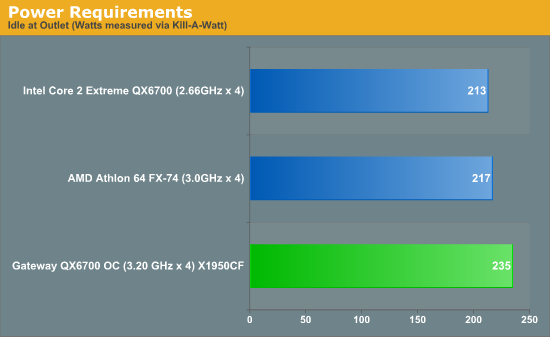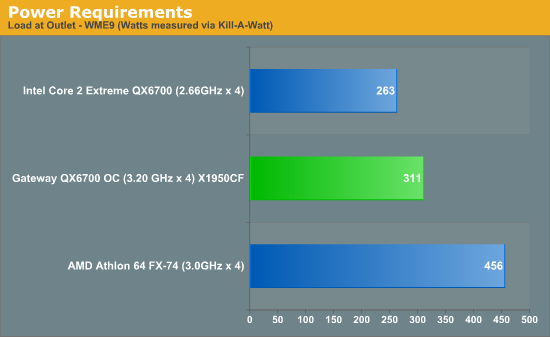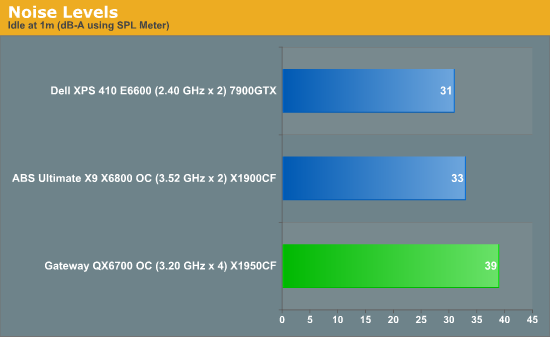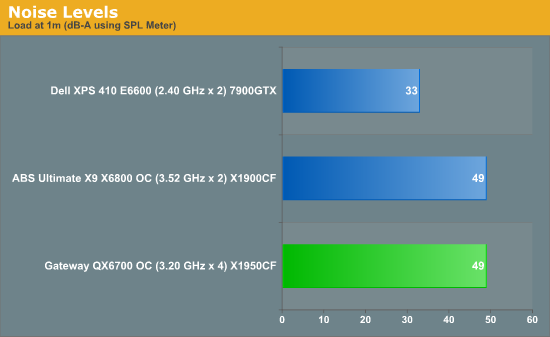Gateway FX530: Mad Cows and Quad Core Overclocking
by Jarred Walton on February 9, 2007 12:01 AM EST- Posted in
- Systems
Power Consumption
Getting this much performance usually comes at a cost, not just in the initial expenditure but also in power bills over time. Intel's Kentsfield processor really isn't all that bad when it comes to power requirements, but Gateway had to jack up the CPU voltage in order to get the overclock to be stable, and combined with the higher clock speed we expect to see higher power draw. We don't have identical configurations, but let's see how the Gateway FX530 stacks up against our own Kentsfield testbed as well as AMD's Quad FX. CPU load was achieved by running the Windows Media Encoder benchmark.


The Gateway FX530 consumes quite a bit more power than our stock Kentsfield configuration, but keep in mind that it has two X1950 XTX graphics cards compared to a single 8800 GTX. Considering the 20% overclock, the power draw a really isn't all that much higher. In comparison to the Quad FX-74 configuration, even an overclocked Kentsfield appears positively thrifty with power use, other than at idle. To make matters worse for Quad FX, the overclocked Gateway system not only uses less power at load, but it also offers significantly better performance. But we already knew that the Quad FX was a difficult platform to justify, so none of this comes as a surprise.
Noise Levels
Given all of the performance being offered, you might expect the Gateway FX530 to be a somewhat noisy computer. While it is by no means silent - particularly when running a CPU intensive task - it's quieter than you might expect. Once again, we tested at idle and load conditions using an SPL meter at a distance of 36".


Compared to several of the other systems that we have reviewed, the Gateway is one of the louder offerings. However, there are some other factors at play. First, even under ideal conditions, the Raptor hard drives kept making periodic clicks that noticeably increased the ambient noise level. As we were testing with the system as configured by Gateway, we expect this sort of behavior to be present for end users. Most likely, one of the various included applications is generating periodic hard drive accesses, and while the Raptor drives are very fast they also tend to be quite a bit more audible than other hard drive solutions. Once we begin to place a load on the CPU, the system fans begin to generate a lot more noise. Even a moderate load on one CPU core immediately increases the fan speeds and noise levels, and as loads are placed on more CPU cores the noise increases until the maximum level of 49 dB is reached.
In general, we would rate the noise levels as being tolerable, and considering the performance offered the noise levels are more than acceptable. This isn't the type of system that would be ideal for use as an HTPC, and we wouldn't recommend having it on in the living room or bedroom if you like to have quiet surroundings in those locales. Depending on how frequently the CPU is fully utilized, the noise levels may be more or less noticeable. More often than not, we would expect a high-end system like this to be stressed by CPU intensive applications, which means the typical noise levels are going to hover at around 44 dB. Trying to keep a system like this quiet is very difficult, however, and we are really quite impressed that Gateway managed to keep noise levels as low as they have.
Getting this much performance usually comes at a cost, not just in the initial expenditure but also in power bills over time. Intel's Kentsfield processor really isn't all that bad when it comes to power requirements, but Gateway had to jack up the CPU voltage in order to get the overclock to be stable, and combined with the higher clock speed we expect to see higher power draw. We don't have identical configurations, but let's see how the Gateway FX530 stacks up against our own Kentsfield testbed as well as AMD's Quad FX. CPU load was achieved by running the Windows Media Encoder benchmark.


The Gateway FX530 consumes quite a bit more power than our stock Kentsfield configuration, but keep in mind that it has two X1950 XTX graphics cards compared to a single 8800 GTX. Considering the 20% overclock, the power draw a really isn't all that much higher. In comparison to the Quad FX-74 configuration, even an overclocked Kentsfield appears positively thrifty with power use, other than at idle. To make matters worse for Quad FX, the overclocked Gateway system not only uses less power at load, but it also offers significantly better performance. But we already knew that the Quad FX was a difficult platform to justify, so none of this comes as a surprise.
Noise Levels
Given all of the performance being offered, you might expect the Gateway FX530 to be a somewhat noisy computer. While it is by no means silent - particularly when running a CPU intensive task - it's quieter than you might expect. Once again, we tested at idle and load conditions using an SPL meter at a distance of 36".


Compared to several of the other systems that we have reviewed, the Gateway is one of the louder offerings. However, there are some other factors at play. First, even under ideal conditions, the Raptor hard drives kept making periodic clicks that noticeably increased the ambient noise level. As we were testing with the system as configured by Gateway, we expect this sort of behavior to be present for end users. Most likely, one of the various included applications is generating periodic hard drive accesses, and while the Raptor drives are very fast they also tend to be quite a bit more audible than other hard drive solutions. Once we begin to place a load on the CPU, the system fans begin to generate a lot more noise. Even a moderate load on one CPU core immediately increases the fan speeds and noise levels, and as loads are placed on more CPU cores the noise increases until the maximum level of 49 dB is reached.
In general, we would rate the noise levels as being tolerable, and considering the performance offered the noise levels are more than acceptable. This isn't the type of system that would be ideal for use as an HTPC, and we wouldn't recommend having it on in the living room or bedroom if you like to have quiet surroundings in those locales. Depending on how frequently the CPU is fully utilized, the noise levels may be more or less noticeable. More often than not, we would expect a high-end system like this to be stressed by CPU intensive applications, which means the typical noise levels are going to hover at around 44 dB. Trying to keep a system like this quiet is very difficult, however, and we are really quite impressed that Gateway managed to keep noise levels as low as they have.










26 Comments
View All Comments
Tuvoc - Saturday, February 17, 2007 - link
Thanks for that.Presumably there was no evidence of throttling while you were testing ? I'm surprised at 1.45v on air at 3.2 that it stayed cool enough. Maybe the BTX case design helps a lot
I have an Intel Quad Core on an ASUS P5N-E SLI 650i which you've reviewed. With vcore on auto (which os presumably the default 1.35v), CPU-Z reports as low as 1.20v under full load, from a starting value of about 1.28 (vdroop on this board is a little higher than normal as you found in your review). But the difference between the Gateway 1.45v BIOS setting and the CPU-Z figure of 1.238v is extreme...
Now if only I could get a proper coretemp program to monitor temps under Vista x64..... (I mean proper core temps, not ASUS Probe temps..)
PrinceGaz - Saturday, February 10, 2007 - link
I know it is already overclocked to 3.2GHz, but it would have been nice if you reported the core-temperatures and found out how much further it would overclock. Assuming of course the options were available in the BIOS for further overclocking and over-volting.anandtech02148 - Saturday, February 10, 2007 - link
Lianli Case would be luxury and modular. you can take out parts just so to fit a 8800gtx.$4000 to spend, there's a riches that this Gateway can only show with a quad cpu. no fancy rams or mobos.
Genx87 - Friday, February 9, 2007 - link
Yup that's a Gateway. I hate their cases btw.bamacre - Saturday, February 10, 2007 - link
Yeah, me too. I think as far as OEM's, Dell has the best cases, hands down.Vidmar - Friday, February 9, 2007 - link
One thing I didn't see mentioned in your article is that all Gateways are now being built (assembled) in the USA. Also all Gateway support is located in the USA as well. I think these two points are major pluses for that company.Vidmar - Friday, February 9, 2007 - link
Ahh now I do see a bit on the support "Finally, Gateway also makes a point that they now offer 100% North America based phone support, so that should generally keep the communication barrier down to a minimum".Thanks!
Crassus - Friday, February 9, 2007 - link
Revisiting the AMD Quad FX-74 power draw under load:When I looked at those numbers, suddenly a scene from one of the Harry Potter movies popped up in my mind. It's Harry waving his wand at something shouting "Ridiculous". In this case, it's a FX-74.
For the record: I run a X2 and am pretty happy with it, and I'm not going to swap it out anytime soon.
shortylickens - Friday, February 9, 2007 - link
This baby uses my companies memory.Operandi - Friday, February 9, 2007 - link
For $4,000 that is pretty blah looking box compared to an XPS or a Lian Li for your custom build.Also in regards to the PSU. Delta make very high quality units, much better then 90% of the "enthusiasts" class PSUs at any rate.